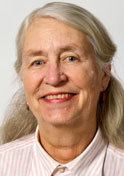Alma mater Harvard, M.I.T. Name Elsa Garmire | ||
 | ||
Education Massachusetts Institute of Technology, Harvard University | ||
Elsa M. Garmire is the Sydney E. Junkins Professor of Engineering at Dartmouth College. She was president of the Optical Society of America in 1993.
Contents
Academic history
Professor Garmire received her B.A. at Harvard and her Ph.D. at M.I.T., both in physics. Her advisor at M.I.T. was Charles Townes, one of the inventors of the laser and a 1964 Nobel laureate.
After postdoctoral work at Caltech, she spent 20 years at the University of Southern California, where she was eventually named William Hogue Professor of Electrical Engineering and director of the Center for Laser Studies. She came to Dartmouth in 1995, where she served 2 years as dean of Thayer School of Engineering.
Author of over 250 journal papers and holder of nine patents, she has been on the editorial board of five technical journals. She is a member of the National Academy of Engineering and the American Academy of Arts and Sciences, a fellow of the Institute of Electrical and Electronic Engineers, a fellow of the American Physical Society, and a fellow of the Optical Society of America; she has served on the boards of three other professional societies. In 1994 she received the Society of Women Engineers Achievement Award. She has been a Fulbright senior lecturer and a visiting faculty member in Japan, Australia, Germany, and China. She has been chair of the NSF Advisory Committee on Engineering Technology and served on the NSF Advisory Committee on Engineering and the Air Force Science Advisory Board.
Professor Garmire was elected to the National Academy of Engineering in 1989 for contributions to nonlinear optics and optoelectronics and for leadership in education.
Work with laser art
In the summer of 1968, Garmire joined the organization Experiments in Art and Technology. She used laser light in artistic presentations, such as a July 1969 "laser wall" made of argon laser beams through which spectators could walk. For the Pepsi Pavilion at Expo '70 in Osaka, Garmire helped E.A.T. build "the world's largest hemispherical mirror."
In her Caltech lab, Garmire experimented with light patterns caused by shining laser beams through transparent random or structured materials, such as dried clear glue on glass or patterned Plexiglas. These diffused the coherent light into abstract shapes with pure colors, internal diffraction pattern texture, and a shimmering speckle. By rotating the diffusing material, the shapes would slowly evolve into new forms.
In November 1970 filmmaker Ivan Dryer visited Garmire's lab, filmed the moving patterns and set them to music. The resulting short movie, LaserImage, dissatisfied both Dryer and Garmire as it lacked the vibrant colors and speckle of live laser light. In December 1970, they proposed to the Griffith Observatory in Los Angeles to present a live laser show in the planetarium, to be called Laserium. The Griffith director at that time turned down the proposal.
She later mused, "I did not patent my idea. I’m a great believer that people should do it. In fact in 1971, I suggested that there could be a home laser light show, and I demonstrated it on television."
In January 1973 Dryer formed a company called Laser Images Inc., with Garmire as president. The company used lasers for a few concerts and special events.
In June 1973, Dryer did a demonstration at Caltech attended by the new director of the Griffith. He agreed to a one-month trial at the Griffith. The first Laserium show was held November 19, 1973. By the end of the trial, 500 people a night had to be turned away from the shows.
At some point, Garmire left the company, later saying "I loved it. I loved the classical music. And when they switched to the rock music, that’s when I decided to absent myself."
While Garmire was not the first "laser artist", it was her work with Dryer that led to the popularization of laser light shows as an ongoing, regularly scheduled presentation. Laser Images' Laserium shows were eventually presented in 46 cities and were seen by over 20 million people as of 2002.
